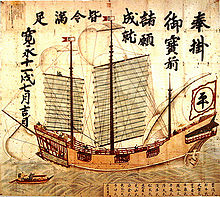- Murayama Tōan
-
Murayama Tōan Antonio (村山等安)[1] was a 17th-century Japanese Governor of the city of Nagasaki (Nagasaki daikan, 長崎代官). He was born in Nagoya from a humble background,[2] and he was a Christian.[3] He played an important role in the handling of "Nanban trade" in Nagasaki with Christian powers, and led an invasion to Taiwan, before being executed for his Christian faith.
Contents
Career in Nagasaki
Murayama went to Nagasaki as a youth and was baptized there, receiving the name "Antonio". He was highly successful in various commercial ventures and became very rich. He also became a famous amateur of European food (南蛮料理 "Nanban-Ryori", lit. "Southern Barbarian Cuisine")[2]
Murayama became very influential in Nagasaki, and was nominated as delegate from the municipal council to Hideyoshi in 1592. Hideyoshi took a liking to him, and even changed his first name to "Tōan" because he could not pronounce "Antonio" easily. Hideyoshi nominated Murayama as the local tax farmer.[2]
Murayama had very close connections with the Jesuits. He had one of his sons, Francisco, ordinated as parish priest of Nagasaki in 1602.[4]
In 1603-1604 Murayama became Governor of Nagasaki in place of Terazawa Shinano-no-kami Hirotaka, following disputes on the price of the silk being provided by the Portuguese. Murayama managed to regulate the silk trade with the Portuguese through the introduction of the "bulk-purchase" pancada system (ito-wappu for the Japanese).[4]
Murayama and his colleague Hasegawa Sahioye Fujihiro got into various disputes with the Jesuits and started accusing them of pride and arrogance, of abusive extraterritorial powers in Nagasaki, and of concealing the best silks from Ieyasu. Murayama advocated for the development of direct trading relations between Japan and China, and for the expansion of the Red seal ship system to carry the silk trade.[5]
Taiwan expedition
In 1616, Murayama Tōan was directed by the Tokugawa Shogunate to invade Taiwan.[6] This followed a first exploratory mission by Arima Harunobu (有馬晴信) in 1609.[7] The objective was to establish a base for the direct supply of silk from China, instead of having to supply it from Portuguese-controlled Macao or Spanish-controlled Manila.[8]
Murayama had a fleet of 13 ships and around 4,000 men, under the command of one of his sons. They left Nagasaki on May 15, 1616.[8] The invasion attempt ended in failure however. A typhoon dispersed the fleet and put an early end to the invasion effort.[9] The king of Ryu Kyu Sho Nei had warned Ming China of the Japanese intentions to capture the island and to use it as a trading base with China, but in any case only one ship managed to reach the island and it was repelled by local forces.[10] The single ship was ambushed in a Formosan creek, and all her crew committed suicide ("seppuku") to avoid capture.[8] Several ships diverted themselves to plunder the Chinese coast and are reported "to have killed above 1,200 Chinas, and taken all the barkes or junks they met withal, throwing the people overboard".[8]
Death
In 1618 Murayama Tōan got into a huge dispute with the Japanese Christian trader Suetsugu Heizo (末次平蔵). Toan first accused Heizo of concealing Jesuits despite the official interdiction, and Heizo accused him of having killed 17 or 18 Japanese from a family who resisted giving him a bride.[11]
Heizo apostized and at the same time accused Murayama of harbouring Spanish priests and his own clerical sons.[11] Murayama Tōan was finally found to be guilty by the Bakufu and executed in 1619 with most of his family.[3]
Murayama Toan's eldest son was Murayama Tokuan Andres.[12]
Notes
- ^ Japanese Journal of Religious Studies, João Paulo Oliveira e Costa p.77 [1]
- ^ a b c Boxer, Charles. R. (1951). The Christian Century in Japan, p. 273.
- ^ a b Jansen, Marius B. (1992). China in the Tokugawa World, p. 8. at Google Books
- ^ a b Boxer, p. 274.
- ^ Boxer, p. 275.
- ^ Taiwan Government [2]
- ^ Taiwan Government [3]
- ^ a b c d Boxer, p. 298.
- ^ Japan's Southward Advance and Australia - Page 34 by Henry P. Frei 1991: "...ordered the Governor of Nagasaki, Murayama Toan, to invade Formosa with a fleet of thirteen vessels and around 4000 men. Only a hurricane thwarted this effort and forced their early return"
- ^ Recent Trends in Scholarship on the History of Ryukyu’s Relations with China and Japan Gregory Smits, Pennsylvania State University, p.13 [4]
- ^ a b Boxer, p. 333.
- ^ Japanese Journal of Religious Studies, João Paulo Oliveira e Costa p.77 [5]
References
- Boxer, Charles. R. (1951). The Christian Century in Japan. Berkeley: University of California Press. OCLC 318190
- Jansen, Marius B. (1992). China in the Tokugawa World. Cambridge: Harvard University Press. 10-ISBN 0674117530/13-ISBN 9780674117532; OCLC 24908621
Categories:- Japanese Roman Catholics
- 1619 deaths
- History of Taiwan
Wikimedia Foundation. 2010.

